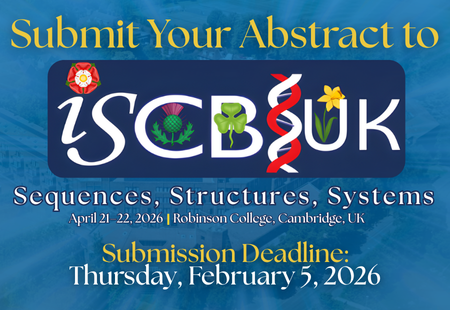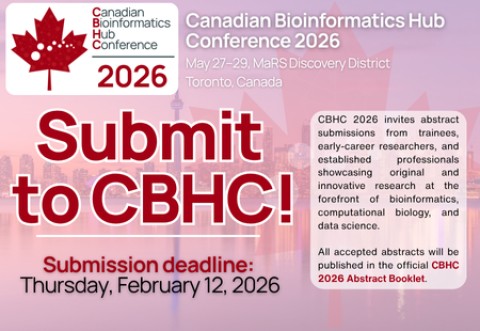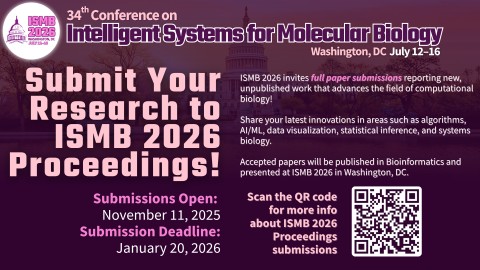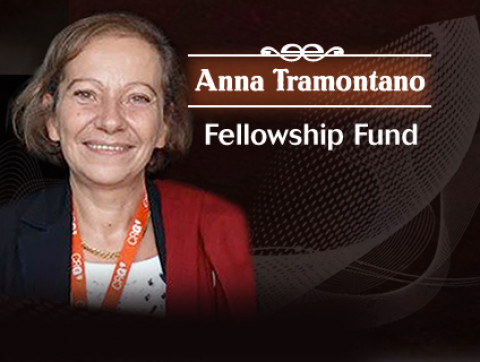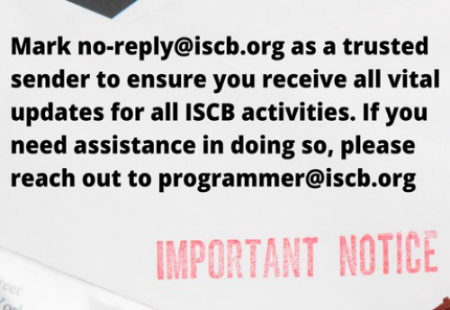Special Session Details
ISMB 2010 will feature Special Session presentations throughout the conference July 11 - July 13. Special Sessions have the purpose of introducing the scientific community to relevant scientific issues and topics that are typically not within the focus of an ISMB meeting. Preliminary program information on Special Sessions is noted below.
(Schedules subject to change)
Special Session 1: Chromatin and Gene Regulation I: Nucleosomes
Organizer(s): Eran Segal
Weizmann Institute
Rehovot, Israel
Date: Sunday, July 11
Start Time: 10:45 a.m. - 12:40 p.m.
Room: 312
Title: Nucleosome positioning from archaebacteria to man
Time: 10:45 a.m. - 11:10 a.m.
Room: 312
Presenter: Jonathan Widom
Eukaryotic genomes are packaged into nucleosome particles that occlude the DNA from interacting with most DNA binding proteins. We have discovered that genomes care where their nucleosomes are located on average, and that genomes manifest this care by encoding an additional layer of genetic information, superimposed on top of other kinds of regulatory and coding information that were previously recognized. The physical basis of the nucleosome DNA sequences preferences lies in the sequence-dependent mechanics of DNA itself. We have an increasingly good ability to read this nucleosome positioning information and predict the in vivo locations of nucleosomes. Our results suggest that genomes utilize this nucleosome positioning code to facilitate specific chromosome functions, including to define the next higher level of chromosome structure. Comparisons across diverse organisms suggests that basic aspects of this nucleosome positioning code may be conserved from archaebacteria to man. While we now have a good theoretical and experimental understanding of the approximate locations of nucleosomes in vivo, many aspects of chromosome structure and function hinge on knowing nucleosome locations to basepair resolution; but current experiments do not come close to this resolution. I will discuss a new experimental approach to obtaining nucleosome maps at high resolution.
Title: Global Interplay between the Transcription Machinery and Chromatin
Time: 11:15 a.m. - 11:40 a.m.
Room: 312
Presenter: Frank Pugh
During meiosis to form gametes or spores, chromosomes undergo dramatic compaction, which might be expected to result in tighter nucleosome packing and loss of nucleosome-free regions (NFRs) at promoters, terminators, tRNA genes, replication origins, and recombinational hotspots. In this talk I will described our most recent attempts at providing ultra-high resolution maps of nucleosome positions and modification states as they progress through meiosis and sporulation. Surprisingly, while linkers transiently expand just prior to meiosis, linker lengths and NFRs remain constant throughout meiosis and spore maturation. At the same time, modification states at individual nucleosome positions recede, except where they are selectively linked to transcription. Thus, genome compaction that occurs at a higher order level maintains the primary structure of chromosomes. This constitutively open state is likely to be important for continuous functioning of the genome as it proceeds through meiosis to form spores.
Title: Transcriptional Lego: Predictable fine tuning of gene expression by manipulating nucleosome positioning signals
Time: 11:45 a.m. - 12:10p.m
Room: 312
Presenter: Eran Segal
The ability to control the timing and levels at which genes are expressed is key to most biological processes. Although we know the sequence preferences of key players in this process, we are still far from understanding how these elements combine within regulatory sequences to encode the transcriptional outcome. Based on our theoretical analyses, we devised hypotheses regarding the effect that different nucleosome disfavoring sequences that vary in length, composition, and distance from transcription factor binding sites, will have on the transcriptional outcome. To systematically test these hypotheses, we designed and synthesized ~80 promoter sequences, and fused each promoter to a fluorescent reporter, resulting in the largest library of designed promoter variants to date. Our results show that by manipulating either or both transcription factor binding sites and nucleosome disfavoring sequences in the vicinity of the site, we can tune expression levels in a predictable manner. Importantly, sequence changes that only alter nucleosome disfavoring sequences result in effects on expression comparable in magnitude to those that result from changes to transcription factor binding sites. In fact, compared to binding site changes, alterations of nucleosome disfavoring sequences likely yield more gradual changes in expression levels, and thus offer means to fine-tune gene expression with high resolution. These results have intriguing implications for evolution of gene expression, suggesting that sequence changes that alter the DNA-encoded nucleosome organization may provide an efficient genetic mechanism by which genomes may evolve and fine-tune gene expression. Overall, our results bring us a step closer towards understanding the role of various promoter elements and their combined effects on transcription, and suggest that directed design of promoter sequences that yield pre-specified expression patterns may be within reach.
Title: Chromatin dynamics during the cell cycle in S. cerevisiae
Time: 12:15 p.m - 12:40 p.m
Room: 312
Presenter: Oliver Rando
Our laboratory uses genome-wide mapping techniques to study the role of chromatin structure in transcriptional control and epigenetic inheritance in fungi. Here, I will present two ongoing efforts in our lab. In the first, we take a comparative genomics approach to nucleosome positioning, and characterize the genome-wide positions of nucleosomes in 14 fungal species spanning a billion years of evolution. In the second, we use two different pulse-chase techniques to measure the dynamics behavior of nucleosomes in budding yeast. We characterize replication-independent histone replacement, and subsequently follow how nucleosomes behave during genomic replication. Our results have interesting implications for the evolution of gene regulation, the role of sequence in nucleosome positioning, and the plausibility of chromatin as a carrier of epigenetic information.
TOP
Special Session 2: Chromatin and Gene Regulation II: Epigenomics
Organizer(s): Manolis Kellis
Broad Institute of MIT and Harvard
Cambridge, MA, USA
Date: Sunday July 11
Start Time: 2:30 p.m. - 4:25 p.m.
Room: 312
While the primary DNA sequence of the human genome is ultimately responsible for the encoding and functioning of each cell, a plethora of chromatin and DNA modifications have been described in recent years that can modulate the interpretation of this primary sequence. These epigenetic modifications lead to the diversity of function across different human cell types, and play key roles in the establishment and maintenance of cellular identity during development, and also in health and disease. Advances in sequencing technology has recently enabled efficient high-resolution mapping of DNA methylation, histone modifications, nucleosome positioning, DNase hypersensitivity, and other epigenetic information across complete genomes. Large-scale data generation projects such as the NIH Epigenome road map, ENCODE, and modENCODE are already leading to tremendous quantities of epigenomic information for human, mouse, fly, worm, and other related organisms. To unlock the vast potential this data for biology and medicine will require further development and application of algorithms and machine learning techniques specifically designed for epigenomic data, to provide systematic analysis and signal discovery, as well as integration with complementary data sets such as gene expression and disease association. The goal of this SIG is to bring together research scientists from the data generation and data analysis side of epigenomic datasets to discuss the unique challenges and opportunities in epigenomics. Invited talks and a panel discussion will present both computational methodologies and biological insights about the complex relationships of combinations of chromatin marks, nucleosomes, and other epigenetic information, and their dynamics across numerous cell types, developmental stages, and disease states. The ISMB community is uniquely positioned to take advantage of these large-scale datasets, and a special session on this topic can bring together practitioners for in-depth discussions and newcomers to expose them to this exciting new area.
Title: Dynamics of chromatin states across multiple human cell lines
Date: Sunday July 11
Start Time: 2:30 p.m. - 2:55 p.m
.
Room: 312
Presenter: Manolis Kellis
Recent large-scale experimental efforts such as the NIH ENCODE and Epigenome Roadmap projects have enabled the systematic study of epigenetic information across both multiple chromatin marks and multiple cell types across the complete human genome. To enable the joint modeling of combinatorial patterns of both chromatin marks and gain/loss patterns across cell types, we first developed a graphical probabilistic model for learning chromatin states from combinations of chromatin marks within each cell type, in a systematic and unbiased way, without prior information on genome annotation. The resulting states reveal surprisingly rich epigenomic information, in several distinct classes of enhancer, promoter, transcribed, active intergenic, repressed, and repetitive states. We next applied our model jointly across multiple cell types, resulting in common chromatin state definitions, revealing chromatin state changes associated with enhancer and promoter activity changes, consistent with the functional roles of corresponding target genes in the surveyed cell types. In multi-cell comparisons across all nine cell types, this has enabled us to define activity profiles for chromatin states, gene expression patterns, transcription factor active and repressive targeting. Correlations in these activity patterns enabled us to link enhancer regions to likely target genes, identify activators and repressors for different states in each cell type, and recognize cell-type specific binding-site resolution footprints of bound factors.
Website: http://mit.edu/manoli/
Title: Unsupervised inference of chromatin domain structure from multiple functional genomics data sets
Date: Sunday July 11
Start Time: 3:00 pm - 3:25 pm
Room: 312
Presenter: William Stafford Noble, Genome Sciences, Computer Science, University of Washington
Sequence census methods such as ChIP-seq have begun to produce an unprecedented amount of genome-anchored data. Numerous techniques exist to analyze the results of single assays, but genomics research has lacked an integrative method to identify patterns from multiple experiments simultaneously, while taking full advantage of the high-resolution data now available. We have developed such a method, which employs a dynamic Bayesian network to discover joint patterns across different experiment types.
We have applied this method to ENCODE chromatin data for the human chronic myeloid leukemia cell line K562, including ChIP-seq data on covalent histone modifications and transcription factor binding, and DNaseI and FAIRE readouts of open chromatin. In an unsupervised fashion, we have identified patterns associated with transcription initiation and elongation, as well as transcriptional repression, finding the locations of genes without using DNA sequence, mRNA or multispecies conservation data. We have also successfully performed a semi-supervised identification of enhancer regions across the genome using a curated set of seed enhancers. In both the unsupervised and semi-supervised cases, the method identifies patterns that elucidate the relationships among open chromatin, various transcription factors and histone modifications.
Website:
http://www.gs.washington.edu/faculty/noble.htm
Title: The Epigenome of Pluripotent Cells: Variations of a Common Theme
Date: Sunday July 11
Start Time: 3:30 pm-3:55 pm
Room: 312
Presenter: Christoph Bock, Broad Institute
Pluripotency describes the ability of embryonic stem (ES) and induced pluripotent stem (iPS) cells to differentiate into every cell type of the body. The focus on cellular potential (rather than the cell's current state) links pluripotency to epigenetic states; and the unique epigenome of pluripotent cells is likely to contribute to their pervasive differentiation potential. We have recently completed a catalog of epigenetic and transcriptional variation in 30 human ES/iPS cell lines. The talk will focus on bioinformatic methods for epigenome analysis and their application to modeling and predicting cellular identity.
Website:
http://bioinf.mpi-inf.mpg.de/homepage/index.php?&account=cbock
Title: Inferring in vivo transcription factor binding from histone mark dynamics
Date: Sunday July 11
Start Time: 3:45 pm-4:10 pm
Room: 312
Presenter:Shirley Liu, Biostatistics, Dana Farber, Harvard School of Public Health
Transcription factor (TF) ChIP-seq has been widely adopted to study transcriptional control over important biological processes and diseases. However, three major challenges exist for TF ChIP-seq: knowledge of the TFs of interest beforehand, availability of ChIP-quality antibodies for the TFs, cost of doing individual TF ChIP-seq separately. We describe a method to detect in vivo cell type and condition specific transcription factor binding locations through an integrative analysis of differentiation- or stimulus-induced shifts in nucleosome occupancy and DNA sequence data. We use a Bayesian statistical framework to integrate ChIP-seq data on nucleosome occupancy shifts with DNA sequence and transcription factor binding motifs to estimate probabilities of transcription factor binding at sites flanked by two positioned nucleosomes. Using this method we screen a library of known transcription factor DNA binding motifs to infer transcription factor binding sites and the identity of transcription factors that are the key regulators of cell differentiation or a response to a stimulus. Through examples looking at gut development and hematopoietic stem cell differentiation, we demonstrate that our method provides an effective way of determining key transcription factors driving cell differentiation or stimulus response.
Website:
http://liulab.dfci.harvard.edu/
Special Session 3: Computational Approaches in Pharmacogenomics
Organizer(s): Pär Matsson
Uppsala University, Sweden
Avner Schlessinger
University of California, San Francisco, CA, USA
Date: Monday, July 12
Start Time: 10:45 a.m. – 12:40 p.m.
Room: 312
About 7% of all hospitalized patients in the US experience adverse drug reactions, resulting in more than 100,000 fatalities annually. It is estimated that genetic factors explain 15–30% of the variability in drug disposition and pharmacological and toxicological effects among humans. Pharmacogenetics and pharmacogenomics are the studies of genetic variation that gives rise to these interindividual differences in drug response. Such approaches will ultimately lead to "personalized medicine", in which drugs and drug combinations are optimized for each individual's unique genotype. In addition to benefiting the individual patients, this will also lead to reduced attrition in drug development, as new drugs can be specifically targeted to patient populations where the risk for rare but serious adverse effects is minimal.
As a recent example of the importance of genetic variation for drug disposition and response, exposure to the cholesterol-lowering drug rosuvastatin was shown to be much lower in individuals of European ancestry than in Chinese individuals. This variability is associated with genetic variation, which appears more frequently in Asians than in any other population. Results from such studies suggest that populations that are underrepresented in clinical trials are likely to get poor medical treatment; however, the magnitude of such controversial inter-ethnic variation is still mostly unknown.
Pharmacogenomics builds on pharmacogenetics and involves the application of genomic/high-throughput technologies to study the genetic component of drug response. These new technologies handle large-scale and diverse data and therefore require an integrated use of advanced computational and experimental techniques. For example, chemical systems biology combines approaches from chemical biology and systems biology to characterize pathways that are affected by drugs, thereby predicting possible off-target side-effects. Similarly, genome-wide association studies have uncovered vast numbers of genetic variants that affect both predisposition to disease and the response to pharmacological treatment, but how the genetic variation affects regulatory networks and pathways of pharmacological action remains largely unknown. Awareness to the pharmacogenomics field will thus be of utmost interest to computational biologists who can develop new methods for handling and integrating diverse pharmacogenomic data and apply them efficiently to explain and predict differential response to drugs in human populations.
Title: Identification and Pharmacogenomic Characterization of Liver Membrane Transporter Enhancers
Date: Monday, July 12
Time: 10:45 a.m. - 11:10 a.m.
Room: 312
Presenter: Nadav Ahituv
Mee J. Kim1, Robin P. Smith1, Pui-Yan Kwok2, Deanna L. Kroetz1, Kathleen M. Giacomini1, Nadav Ahituv1
1Department of Bioengineering and Therapeutic Sciences, 2Cardiovascular Research Institute, University of California, San Francisco, San Francisco, CA
Liver membrane transporters play an important role in determining individual drug response due to their involvement in hepatic uptake and elimination. Numerous pharmacogenomic assays have demonstrated that nucleotide variation in the coding regions of these transporters and differences in their expression levels have a strong influence on drug response. However, little is known about how genetic variation in enhancers, sequences that regulate gene promoters, influence transporter expression and function and how they contribute to differences in drug response. In our laboratory we are using a combination of comparative genomics, transcription factor binding site analyses and chromatin immunoprecipitation (ChIP) in combination with next-generation sequencing technologies (ChIP-seq) to identify potential enhancers of liver membrane transporters. These sequences are then rapidly analyzed for enhancer activity in vivo using the mouse hydrodynamic tail vein assay. This assay utilizes a rapid intravascular injection of DNA into the mouse tail vein, leading to its specific expression in the liver. Positive enhancers are then analyzed for nucleotide variation and selected common variants are further assayed for differential enhancer activity compared to the reference allele using the hydrodynamic tail vein assay. Combined, these studies provide a model for elucidating how nucleotide variation in enhancer sequences can contribute to inter-individual differences in drug response. Furthermore, understanding how genetic variability in membrane transporters influences drug response and adverse drug effects will ultimately lead to more efficacious and efficient treatments.
Title: Can high-throughput genomics data identify new therapeutic targets in cancer?
Date: Monday, July 12
Time: 11:15 a.m. - 11:40 a.m.
Room: 312
Presenter: Rachel Karchin
Department of Biomedical Engineering and Institute for Computational
Medicine, Johns Hopkins University, Baltimore, Maryland, USA.
Major public and private efforts are underway to systematically resequence tumor genomes, measure their transcriptomes and identify epigenetic aberrations, with the hope that analysis of this data will fundamentally change the way cancer is treated. By identifying the oncogenic addictions and altered pathways in a certain cancer type or subtype, the cancer genomics community aims to help pinpoint targeted therapies or combinations of therapies that will most benefit individual patients, and to shorten time and reduce costs involved in drug development. I will discuss two software tools being developed in my group to assist these efforts. CHASM is a machine learning method that attempts to find genes not previously linked to tumorigenesis that may be somatically mutated in a relatively small fraction of tumors, but are important for tumor initiation or progression. TOPPER combines the expression, copy number, methylation and mutation measurements of individual genes assessed in high-throughput cancer genome experiments and detects functional gene sets/pathways enriched for sample/patient phenotypes (such as drug response).
Website: http://karchinlab.org
Title: Genetic factors affecting severe adverse effects for common drugs
Date: Monday, July 12
Time: 11:45 a.m. - 12:10 p.m.
Room: 312
Presenter: Itsik Pe’er
The Serious Adverse Events (SAE) Consortium; Department of Computer Science, Columbia University, NY, USA
Severe adverse effects are rare, but debilitating, potentially lethal syndromes. The strong motivation to find underlying causes for such adverse reactions, with the limited sample size accessible to each pharmaceutical company, brought together industry and academia to partner and conduct a series of genomewide association studies for multiple adverse effects, caused by multiple drugs. We present genomewide significant results, exposing multiple novel alleles that are strongly associated to drug induced liver injury due to flucloxacillin and coamoxiclav, as well as Torsades (prolonged QT) syndrome. Due to the involvement of HLA variation in these phenotypes we developed a new graph-based computational approach for accurately imputing HLA alleles.
Title: The Genome Commons
Date: Monday, July 12
Time: 12:15 a.m. - 12:40 p.m.
Room: 312
Presenter: Steven Brenner
Steven E. Brenner1,2,3, Reece K. Hart2, Robert L. Nussbaum4,5, Bernard Lo6,7, Jasper Rine2,3
1Department of Plant & Microbial Biology, 2California Institute for Quantitative Biology,
3Department of Molecular & Cell Biology, University of California, Berkeley, 4Division of Medical Genetics, Department of Medicine, 5Institute of Human Genetics, 6Division of General Internal Medicine, Department of Medicine, 7Program in Medical Ethics, University of California, San Francisco, CA
Exome sequences are now flowing in abundance and complete genomes can be completed by individual research labs. Unfortunately, today one can do relatively little of value with a single personal genome, due to a variety of scientific, technical, legal, sociological, and ethical challenges.
For this reason we are constructing a Genome Commons, open-source open-access research resources aiding the scientific interpretation of personal genomes. The Genome Commons Database will integrate and augment existing data sources of genetic variation and human disease. We are also developing a curators’ toolkit to facilitate manually verified entry of data into the commons. The Genome Commons Navigator prioritizes and predicts phenotypes of genetic variants within an individual genome. The Genome Commons Navigator will be an open framework that draws upon the Genome Commons database as well as an array of plug-in modules.
We aim for the Genome Commons and Navigator to be used in the research community to improve the methods to make new discoveries, and in analyzing exomes of individuals with genetic disease of unknown genetic origin. We also intend to make the Navigator accessible for making pharmacogenomic recommendations to clinicians.
In collaboration with John Moult, we are sponsoring a Critical Assessment of Genome Interpretation (cagi, \kā′-jē\) which will assess predictions of molecular, cellular, or organismal phenotypes.
Any use of genomic information and its interpretation raises challenging ethical questions, such as mitigating misinterpretation and misuse of genotype-phenotype relationships by the lay public, addressing issues of data attribution, and managing privacy issues associated with private mutations, where even a single nucleotide variant could potentially uniquely identify an individual. For this reason an ethics core is an essential component of our research effort.
Special Session 4: The Future of Scientific Publishing
Organizer(s): Scott Markel
Accelrys, San Diego, CA, USA
Date: Monday, July 12
Start Time: 2:30 p.m. - 4:25 p.m.
Room: 312
Scientific publishing is a critical part of the work we do as scientists. It is vital that there be an ongoing dialogue between scientists and publishers. ISMB is a wonderful venue for fostering this kind of exchange as the publishers are typically well-represented among the exhibitors and are eager to have a forum such as this to discuss the topics of interest to both the researchers and the publishers.
Discussion topics at last year's session included semantic technologies, Web 2.0 technology, quality control, archiving, metrics for each article, experimental data associated with articles (especially large data sets), versioning of articles, impact of open access publishing on traditional publishing, and impact factors.
2:30 - 3:25 Opening remarks by panelists
Confirmed panelists:
Jen Boyd (Oxford University Press)
Theo Bloom (Public Library of Science)
Rachel Burley (Wiley)
Matt Cockerill (BioMed Central)
Anita de Waard (Elsevier)
3:30 - 4:25 Open discussion with panelists
Theo Bloom
Various initiatives at PLoS towards the journal of the future and the article of the future.
http://www.plos.org/about/people/biology.php
Rachel Burley
ORCID
http://www.linkedin.com/in/rachelburley
Matt Cockerill
OA Publishing in 2010: iPads, epubs, datasets and the cloud
http://www.biomedcentral.com/info/about/whoweare
Anita de Waard
The Future of the Journal (http://www.slideshare.net/anitawaard/vu210610futurejournal)
http://elsatglabs.com/labs/anita/
TOP
Special Session 5: Visualization of biological networks
Organizer(s): Igor Jurisica
Ontario Cancer Institute, Princess Margaret Hospital/UHN,
Toronto, ON, Canada
Date: Tuesday, July 13
Start Time: 10:45 a.m. – 12:40 p.m.
Room: 312
There are many network visualization software packages, such as Cytoscape, VisANT, NAViGaTOR, Pajek, Osprey, Ondex, PathwayLab, Interviewer3, Geomi, Forg3d to name a few. Some are open source, while others are public or commercially available. Individual systems differ greatly in terms of features they support, standards they adhere to and many user interaction features.
We aim to highlight two important aspects in this session. First, there are many scenarios or uses cases where network visualization tools emerge as preferred data mining approach while interpreting complex biological data. Second, standardization of data input and output combined with rich features of individual tools is essential. Since it may be beneficial to use specialized tools for specific tasks, the tools need to be integrated to enable more complex analyses. Our goal in organizing the session is to highlight both aspects and directly involve tool developers with biologists in a dialogue to focus future development in the most useful direction.
Prior to the meeting we will provide a “challenge dataset”, and report on the results with highlighting the most promising systems; selected systems will also be presented in a poster session. We will invite ISMB attendees to comment on the tools, their features and use, so we can provide specific recommendations of what are positive and negative features as perceived by potential users of these tools.
Title: Introduction – Tools and their features for biological network analysis and visualization
Time: 10:45 a.m. - 11:10 a.m.
Room: 312
Presenter: Igor Jurisica
Biology offers diversity of problems, leading to many computational biology workflows, including tasks where network visualization is helpful during data interpretation and analysis. Individual network visualization software systems, such as Cytoscape, VisANT, NAViGaTOR, Pajek, Osprey, Ondex, PathwayLab, Interviewer3, Geomi, Forg3d to name a few, differ greatly in terms of features and standards they support, and consequently analyses they enable.
Biography:
Dr. Jurisica, Canada Research Chair in Integrative Computational Biology, is a senior scientist at the Ontario Cancer Institute, Associate Professor in the Departments of Computer Science and Medical Biophysics at University of Toronto, and Visiting Scientist at IBM's Centre for Advanced Studies. He is also an Adjunct Professor at School of Computing, Queen's University and Department of Computer Science at York University.
His research focuses on cancer informatics, and the representation, analysis and visualization of high-dimensional data from high-throughput biology experiments.
URL:
http://www.cs.utoronto.ca/~juris
Title: Visualization of large networks
Time: 11:15 a.m. - 11:40 a.m.
Room: 312
Presenter: Frank van Ham
Networked data (or graphs as they are called in mathematics) forms an increasingly important part of data that is captured in many different data domains. One can think of social networks, citation networks, genetic/biological networks or program call graphs. However, analyzing this data is a significant challenge without a proper mental image, even for smaller networks. While we can create acceptable visualizations for networks of a few hundred nodes, properly visualizing complex networks of tens of thousands of nodes remains an open problem. In this talk I will give an overview of the state of the art in large graph visualization. I'll discuss three main approaches to the problem at a high level and illustrate them with samples from recent research where possible.
Biography:
Dr. Frank van Ham is a research staff member at IBM. After obtaining his PhD in Computer Science in Eindhoven, The Netherlands he joined IBM Research in Cambridge, USA as a post-doc and later as a full-time researcher. Dr. van Ham's main research interests are large network visualization, visual interfaces and collaborative visualization. Currently, he is embedded with ILOG (a recent IBM acquisition) in Paris, France where he works on integrating his research into IBM product.
URL:
http://domino.watson.ibm.com/cambridge/research.nsf/pages/frank_van_ham.html
Title: Visual interpretation of biological data using networks
Time: 11:45 a.m. - 12:10 p.m.
Room: 312
Presenter: Gary Bader
Enrichment maps organize the results of gene set enrichment analysis as a network to provide a quick visual summary of gene function enrichment. Users can explore the map to zoom in to functions of interest for deeper exploration. I will also present some experimental network visualization features in Cytoscape.
Title: Visualization and analysis of signaling pathways
Time: 12:10 p.m. - 12:40 p.m.
Room: 312
Presenter: Lincoln Stein
We have built a network of high-probability functional interactions by integrating many sources of interaction data with a high-quality hand-curated set of pathways from Reactome (
www.reactome.org). This talk will discuss how this functional interaction network can be used to gain insight into the mechanisms of several cancer tumor types.
URL:
http://www.oicr.on.ca/research/stein.htm
TOP
Special Session 6: Data Analysis in Genome-scale RNAi Research
Organizer(s): Xiaohua Douglas Zhang
Merck Research Laboratories
West Point, PA, USA
Date: Tuesday, July 13
Start Time: 2:15 p.m. - 4:10 p.m.
Room: 312
RNA interference (RNAi) is a mechanism in living cells that helps determine what genes are active and how active they are. The development of algorithms for RNAi design that produce potent and selective knockdown of targeted genes has led to a great deal of interest in using RNAi to elucidate gene function, to identify novel targets for drug discovery, and to reveal the molecular biological system. The importance of RNAi was further recognized when the Nobel Prize in Medicine and Physiology was awarded to Drs. Fire and Mello in 2006 for their research in this field.
The genome-scale RNAi study allows genome-wide loss-of-function screening. One of the major advantages of the genome-scale RNAi researches is their ability to simultaneously interrogate thousands of genes. With the ability of generating a large amount of data per experiment, the genome-scale RNAi researches have led to an explosion in the rate of data generated in recent years. Consequently, one of the most fundamental challenges in the genome-scale RNAi researches is to glean biological significance from mounds of data, which relies on the development and adoption of statistics/bioinformatics methods for both quality control and hit selection. Therefore, it is important to present this important developing area in ISMB.
For quality control, Zhang J et al (1999) proposed the popular Z-factor and Zhang XHD (2007, 2008) proposed strictly standardized mean difference (SSMD). For hit selection, Brideau et al (2003) proposed B-score method; Zhang XHD et al (2006, 2008) proposed a median-MAD method, a quartile-based method and a Bayesian approach; Zhang XHD (2007, 2008, 2009) proposed the SSMD-based method. Konig R et al (2007) proposed an analysis method incorporating redundant siRNA activity to address for off-target effects. Boutros et al (2006) developed analytic tools including R-libraries for analyzing RNAi screens. Malo et al (2006) and Birmingham A et al (2009) reviewed the methods developed recently. The recent development of statistics/bioinformatics methods in this important developing area makes it a right time for a special session on this topic in ISMB 2010. In this session, investigators will share their frontier research on data analysis, methodology development and application of bioinformatics/statistics in this important developing area.
Title: Methods for the Efficient Implementation of siRNA High Throughput Screens
Date: Tuesday, July 13
Time: 2:15 p.m. - 2:40 p.m.
Room: 312
Presenter: Shane Marine, Cellular Discovery Biology, Department of Automated Biotechnology USA
Loss-of-function genetic screens using RNAi allows for the identification of genes involved in specific biological processes that result in human diseases. Genome-wide RNAi has therefore become a powerful tool for the identification of new targets for drug discovery. This presentation will explain how genome-wide high throughput siRNA screens are being implemented to support target identification efforts at Merck. It will also highlight efforts to improve the screening process by implementing novel RNAi technologies and robust experimental and statistical methods to efficiently select true hits and remove potential false positives due to off-target effects and variance in the assays. The presentation will demonstrate such siRNA screening approaches by showing case studies.
Title: Massively Parallel Phenotyping by High-throughput RNAi
Date: Tuesday, July 13
Time: 2:45 p.m. - 3:10 p.m.
Room: 312
Presenter: Michael Boutros, German Cancer Research Center and University of Heidelberg, Germany
While an increasing number of genomes are sequenced, the function of many genes remains unknown. Genetic screens for phenotypes on the level of the organism have been successfully used to characterize the function of genes and order their action into cellular pathways. High-throughput RNAi screens now allow a phenotypic characterization of genes on a genome-wide scale and support a systems-level understanding of cellular processes. We have developed approaches to rapid screen through large libraries of RNAi reagents to identify genes that are required for particular biological processed. We show how strategies derived from classical genetic screens in combination with quantitative HTS and HCS phenotypes can be used to dissect cellular signaling networks. A particular focus of the presentation will be on strategies and challenges in the analysis of large-scale phenotypic data sets.
Title: Development of analytic methods in genome-scale RNAi researches
Date: Tuesday, July 13
Time: 3:15 p.m. - 3:40 p.m.
Room: 312
Presenter: Xiaohua Douglas Zhang, Merck Research Laboratories, USA
The genome-scale RNAi study allows genome-wide loss-of-function screening. One of the major advantages of the genome-scale RNAi researches is their ability to simultaneously interrogate thousands of genes. With the ability of generating a large amount of data per experiment, the genome-scale RNAi researches have led to an explosion in the rate of data generated in recent years. Consequently, one of the most fundamental challenges in the genome-scale RNAi researches is to glean biological significance from mounds of data, which relies on the development and adoption of statistics/bioinformatics methods that are suitable for analyzing RNAi screens. Recently, we have been developing novel analytic methods specifically for quality control and hit selection in genome-scale RNAi screens. I will present these recently developed analytic methods and demonstrate how to use them in RNAi high-throughput screens.
Title: Computational Assessment of Screening Statistics for RNAi
Date: Tuesday, July 13
Time: 3:45 p.m. - 4:10 p.m.
Room: 312
Presenter: Amanda Birmingham, Thermo Fisher Scientific, USA
RNA interference (RNAi) has become a powerful technique for reverse genetics and drug discovery but researchers often struggle with how best to derive hits from RNAi high-throughput screening data. Although a wide range of hit identification techniques exist, little information is available about their sensitivity and specificity, especially in comparison to each other. To address this issue, we have developed the open-source NoiseMaker software tool for generation of realistically noisy virtual screens. By applying potential hit identification methods to NoiseMaker-simulated data and determining how many of the pre-defined true hits are recovered (as well as how many known non-hits are misidentified as hits), one can draw conclusions about the likely performance of these techniques on real data containing unknown true hits. Using this approach, we present the results of a systematic comparison of multiple normalization, replicate combination, and hit identification techniques recommended for RNAi data under several relevant screen noise scenarios.


